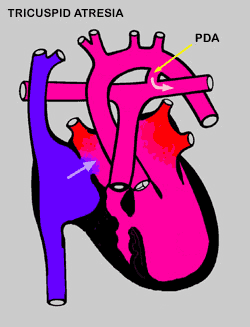 (rollover to compare with closed) (rollover to compare with closed) |
|
What Are Its Effects?
The persistence of the Patent Ductus Arteriosus (PDA) after birth may cause difficulties depending on it’s size. Because the pressure is higher in the aorta than the pulmonary arteries, there can be excess blood flow in the pulmonary arteries. This can produce a characteristic heart murmur. If the PDA is small only a murmur is present and the child will be asymptomatic. If the PDA is medium to large, excess blood flow to the pulmonary arteries can result in heart failure, particularly in premature infants. A large PDA if not diagnosed in childhood can result in persistent pulmonary artery hypertension that could be fatal. Some PDAs are so small that not even a murmur can be heard and are found incidentally during echocardiograpy. This “silent PDA” usually does not require treatment.
In some congenital heart defects (eg. Tricuspid Atresia, Hypoplastic Left Heart), the PDA is actually a benefit as it allows necessary mixing of blood. However, when the PDA closes, as it normally does soon after birth, children with these defects experience problems which require treatment.
The rollover diagram to the left shows the dramatic affect of PDA closure in a heart affected by Tricuspid Atresia. This is represented by the change in color of the blood (the redder, the higher the oxygen concentration). |